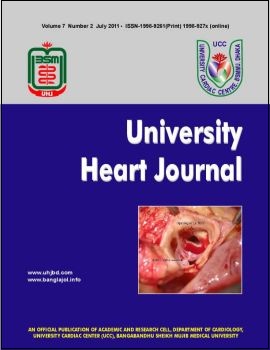Value of ST Segment Changes in 12 Lead ECG to Detect Proximal Versus Distal Right Coronary Artery Occlusion in Acute Inferoposterior Myocardial Infarction
DOI:
https://doi.org/10.3329/uhj.v7i2.10844Keywords:
Inferoposterior wall AMI, RCA occlusion, ST-segment changesAbstract
Background: A history of ischemic-type discomfort & the initial 12- lead ECG are the primary tools for screening patients with acute myocardial infarction in the emergency department. ST elevation in inferior leads indicates an evolving myocardial infarction of the inferoposterior wall. The outcome of patients with inferoposterior myocardial infarction due to occlusion of right coronary artery depends mainly on the location of occlusion (distal versus proximal).
Hypothesis: Value of ST-segment depression in lateral leads (I and aVL) and ST-segment changes in lead V1 to predict the site of right coronary artery occlusion in the case of an inferoposterior myocardial infarction.
Objective: To predict the site of right coronary artery (RCA) occlusion ( proximal or distal) in acute inferoposterior myocardial infarction by ST segment depression in leads 1 & aVL and ST-segment changes( is electric/ elevated or depressed) in V1.
Methods and Results: A total of fifty four patients of ST-segment elevation inferoposterior wall AMI due to suspected RCA occlusion, admitted within 12 hours of onset of chest pain, and subsequently underwent coronary angiography during hospitalization, were selected for the study. Patients were divided into two groups on the basis of angiographic findings: proximal RCA occlusion (group I) and distal RCA occlusion (group II). A 12 lead ECG was taken on admission. ST segment deviation in lateral leads (I & aVL) as well as in precordial lead (V1) was calculated. Isoelectric or elevated ST-segment in V1 predicted proximal RCA occlusion whereas depressed ST-segment predicted distal RCA occlusion. It was demonstrated that, STsegment changes in precordial lead (V1) was a sensitive & specific marker to discriminate proximal & distal RCA occlusion in inferoposterior wall AMI with high positive & negative predictive value, but ST-segment changes in lateral leads (I & aVL) although more specific for proximal RCA occlusion did not seem to be of clinical value due to its low sensitivity.
DOI: http://dx.doi.org/10.3329/uhj.v7i2.10844
University Heart. Journal Vol. 7, No. 2, July 2011
Downloads
250
186

